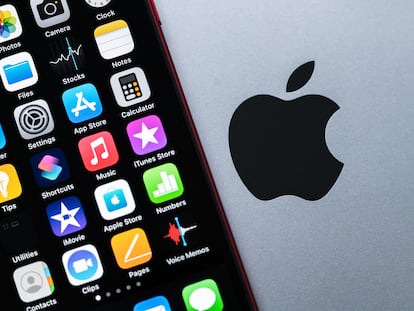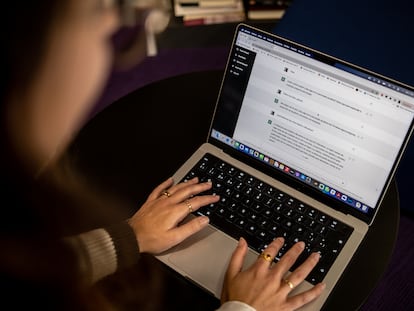An iPhone shield and a keyboard in the palm of your hand: Big tech’s craziest ideas
Brands like Apple, Google and Samsung have filed patents for products that never make it to the market
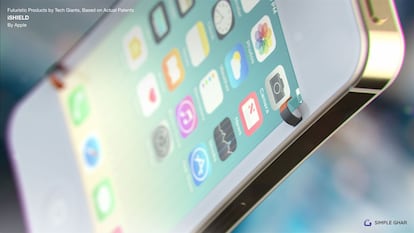
Patent registration reveals manufacturers’ enormous efforts to innovate, but the ideas included in them don’t always translate into products on the market. There are items that, for various reasons, remain in the pipeline and never receive permission to be produced and marketed. The e-commerce company Simple Ghar has collated some of the ideas – which fall somewhere between the transgressive and the innovative – that the big tech companies decided to patent but decided not to sell.
Imagine dropping your cell phone on the floor but knowing for certain that the screen would remain unscathed, not because of its resistance but because it has an innovative shield. This is the idea behind the iShield, a curious patent that Apple registered; the iShield has sensors and prevents disaster in the event of a cell phone hitting the ground. The system’s principle is similar to the one behind airbags in cars: a sensor detects the free fall of an iPhone, and when that happens, four ‘legs’ – which are hidden at the edges of the screen – are deployed, preventing the screen from touching the ground on impact.
Unfortunately, this seemingly brilliant idea, along with the rest of the proposals described below, never saw the light of day. That’s because companies customarily file multiple patents, but only a few ever end up as a product on the market.
“There’s a big difference between patents and the real world,” explains Alex Barredo, the creator of the popular Mixx.io technology podcast. “In many cases, a final product not only requires dozens or hundreds of patents to be filed at various stages; it must also license other patents,” he says.
Ultimately, a patent is just an idea on paper; it has been developed in the isolation of a laboratory or department. After that, the company’s production, cost and commercial departments start working to transform a dream into reality, and they evaluate whether or not the product can be monetized. According to Barredo, “the main reasons for a negative assessment are the cost, required investment, deviation from other businesses, or even a contraindication to [the company’s] current business.”
“Patents give us a clue as to where manufacturers are going,” explains Fran Besora, the founder of Apple’s Spanish Twitter community. Besora notes that Apple “has already patented a folding screen for the iPhone.” While patents provide hints of what’s to come, there is no guarantee that the products mentioned therein will be successful, although they do help us to imagine truly innovative products.
Perfect video calls and a ‘flying’ camera for Zoom meetings
For example, Facebook filed patent US16/120,715, which mentions a pocket video camera that, when plugged in, levitates on its axis to deliver the perfect shot. Because of the increase in teleworking, Zoom and similar video meetings have proliferated, and it’s not always easy to find a good place to capture an acceptable image from the camera.
Lighting or framing can be a problem, not to mention the need to remain still until the video call is over. Facebook’s camera eliminates those issues. It has a magnetic field that is activated when the camera is turned on, and it follows the user’s movements wherever they go, so that they are always at the center of the frame.
A screen is unnecessary; just use your hand
Google has long flirted with the idea of smart glasses that would provide the user with great added value. The famous Glasses ended up crashing and were considered to be a product ahead of its time. However, it seems that the California-based company has not yet given up on that idea; Google has a patent for glasses that project a touch screen onto the palm of the user’s hand.
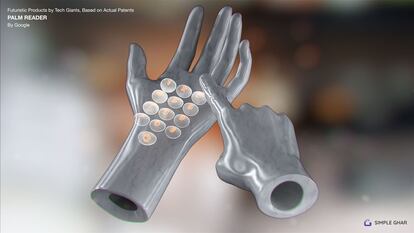
Imagine that we receive a WhatsApp message and want to answer it quickly without taking our cell phone out of our pocket: Google’s patent US14/735,398 allows for answering the message by projecting a keyboard onto the palm of our hands as we respond with the other hand. Although the aforementioned patent is limited to the virtual keyboard, one imagines that Google’s plans for the smart glasses will go much further.
Smart contact lenses
Who doesn’t remember The Terminator? Arnold Schwarzenegger’s cyborg killer robot had a vision system that projected more information than retinas could capture. Samsung came up with contact lenses that, when wirelessly connected to a cell phone, provide users with all kinds of information about what appears right before their eyes.
For example, if you are looking at a dog, the contact lenses record the scene, send it to the cell phone and, from there, return it to the contact lenses, which project additional information to your eyes, such as the dog’s breed, weight, and so on. In short, the product was an evolved version of Google’s glasses but in the form of contact lenses.
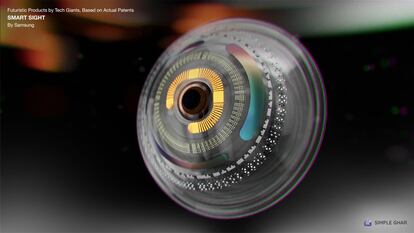
Patents are just the tip of the iceberg in the technology world’s overall creative process and behind-the-scenes work. Whether a product subsequently sees the light of day depends on a company’s strategic and economic criteria. But such formulas are not always reliable.
For instance, in 1993 Apple hit the nail on the head with its famous Newton, a precursor to the iPad, which simply arrived too early. The mobile device was a sales flop, but that doesn’t mean that it should be considered a total failure: “Without experiments, there’s no success,” says Barredo.
Something similar happened to Microsoft with Windows 8, an innovative version of the platform that is now celebrating its tenth anniversary. That version of Windows incorporated a real revolution into the interface, which was called Metro and featured living ‘windows’ that were updated in real time (referred to as ‘Tiles’). But they were a resounding failure, and nobody liked them. Why? “It was too radical a change [and it] came too soon,” Steven Sinofsky acknowledged, somewhat bitterly. Metro in Windows 8 worked very well, but the market was not ready for that change yet.
Sign up for our weekly newsletter to get more English-language news coverage from EL PAÍS USA Edition.
Tu suscripción se está usando en otro dispositivo
¿Quieres añadir otro usuario a tu suscripción?
Si continúas leyendo en este dispositivo, no se podrá leer en el otro.
FlechaTu suscripción se está usando en otro dispositivo y solo puedes acceder a EL PAÍS desde un dispositivo a la vez.
Si quieres compartir tu cuenta, cambia tu suscripción a la modalidad Premium, así podrás añadir otro usuario. Cada uno accederá con su propia cuenta de email, lo que os permitirá personalizar vuestra experiencia en EL PAÍS.
¿Tienes una suscripción de empresa? Accede aquí para contratar más cuentas.
En el caso de no saber quién está usando tu cuenta, te recomendamos cambiar tu contraseña aquí.
Si decides continuar compartiendo tu cuenta, este mensaje se mostrará en tu dispositivo y en el de la otra persona que está usando tu cuenta de forma indefinida, afectando a tu experiencia de lectura. Puedes consultar aquí los términos y condiciones de la suscripción digital.
More information
Archived In
Últimas noticias
More than 40 Democratic lawmakers urge Trump in a letter to stop his ‘attempts to undermine democracy in Brazil’
The journal ‘Science’ criticizes Trump’s anti-renewable energy policy: ‘The US is failing to benefit from its own innovations’
Cubans hope for a miracle as dengue and chikungunya spread
The long shadow of the father figure in the films of Rob Reiner
Most viewed
- Christian Louboutin: ‘Young people don’t want to be like their parents. And if their parents wear sneakers, they’re going to look for something else’
- Cartels in Mexico take a leap forward with narco-drones: ‘It is criminal groups that are leading the innovation race’
- ‘El Limones’ and the growing union disguise of Mexican organized crime
- Liset Menéndez de la Prida, neuroscientist: ‘It’s not normal to constantly seek pleasure; it’s important to be bored, to be calm’
- The low-cost creative revolution: How technology is making art accessible to everyone

